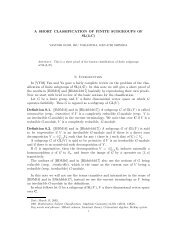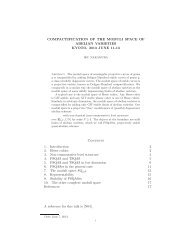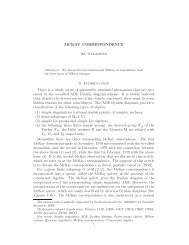GEOMETRIC APPROACH TO GOURSAT FLAGS * Richard ...
GEOMETRIC APPROACH TO GOURSAT FLAGS * Richard ...
GEOMETRIC APPROACH TO GOURSAT FLAGS * Richard ...
- No tags were found...
You also want an ePaper? Increase the reach of your titles
YUMPU automatically turns print PDFs into web optimized ePapers that Google loves.
By the sandwich lemma L(D s;1 )(p) isahyperplane in D sNt . Every such hyperplane isisotropic, so (6.6) implies that either X pNt 2 L(D s;1 )(p) orthat X pNt is a nonzero vectorin the kernel of the 2-form (d! Nt )j DsNt . The latter possibility isexcluded by the conditionX pNt 2 V Nt (p), the orthogonal complement toL(D sNt )(p) =ker(d! Nt )j DsNt .Proposition 6.1 is now proved. Q.E.D.Proof of Proposition 6.2. The proofs of the statements of Proposition 6.2 with`>0 are almost the same as as the proof we have justgiven. The dierence occurs mainlyin the construction of the dieomorphism Nt by the ordinary dierential equation (6.2).Concerning the case of part 1, the problem is that if X Nt is a time-dependent vector eldson a neighborhood U of a point p then its ow willtypically map out of that neighborhood{ hence the business with domains U N i in part 1. Although there may benosingle ow Nt t2 [0 1] of dieomorphisms on a single neighborhood of p, nevertheless, for N largethe vector X Nt (p) issuciently close to zero so that its solution denes dieomorphisms Nt : U N 1 ! U N 2t, t 2 [0 1], where U N 1 is a neighbourhood of p contained in U and U N 2t isan open subset of U (which mayormay not contain p).In the case of part 2 we have toshowthat t (p) =p and U 2t contains p. This followsbecause X Nt (p) =0for all t.The proof of Proposition 6.2 part 2 with l =0is also the same, except that we meet adicultyinthe rst step of the proof. Wehavetoshow that the restriction t (p) ofthe formd!+t(d~!;d!)tothe space D s (p) = D ~ s (p) doesnot vanish for all t 2 [0 1]. This is true fort =0and t =1,but if l =0then d!(p) might not be close to d~!(p) even in the C 0 -topologyand consequently t (p) mightvanish for some t 2 (0 1). Since t (p) depends linearly on t,this is impossible if 0 and 1 dene the same orientation of the 2-space D s (p)=L(D s )(p)(the orientations are well-dened since L(D s )(p) isthe kernel of 0 (p) and 1 (p)). If theorientations are dierent then we have toshow the existence of a symmetry of the germat p of the distribution D s;1 which also preserves !(p) and the foliation L(D s )(p) andchanges the dened above orientation. We can nd local coordinates centered at p suchthat L(D s;1 )=(dx 1 :::dx s+1 ) ? and L(D s )=(dx 1 :::dx s+1 dx s+2 ) ? , and such thatthe forms dening the D i can be taken to be independent ofx j , j s +2. It follows fromthe sandwich lemma that the dieomorphism x s+2 !;x s+2 is a symmetry of the requiredtype.Appendix A. Generalization of the Gray TheoremGray's theorem states that for any path of global contact structures D t t2 [0 1] on anodd-dimensional manifold M there exists a family of global dieomorphisms t : M ! Msuch that ( t ) D t = D 0 t 2 [0 1]. See [Gray, 1959]. It follows that two global contactstructures D and ~ D are equivalentprovided that ~ D is suciently close to D in the WhitneyC 1 -topology.In this section we generalize Gray's theorem to corank one distributions D of anyconstant class. Let ! be any nonvanishing 1-form describing D near p. Bytheclass of Dat p we will mean the odd number 2r+1 such that !^(d!) r (p) 6= 0and!^(d!) r+1 (p) =0.The even integer 2r is the rank of the restriction of the two-form d! p to D p .A corank one distribution has constant class if this class 2r +1does not depend on26





